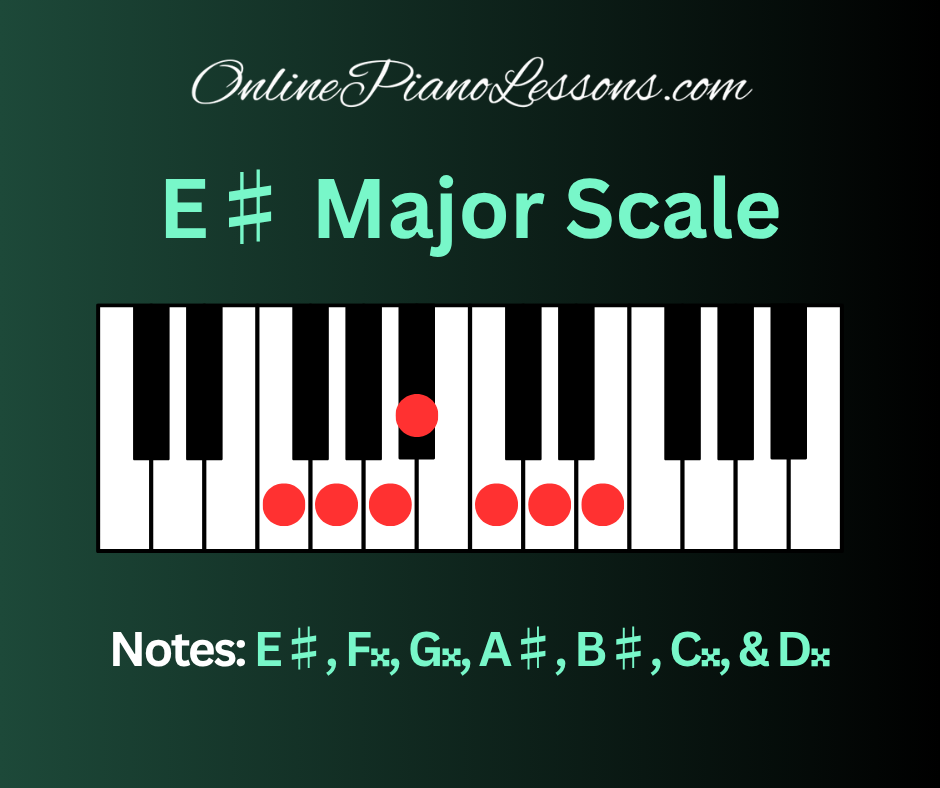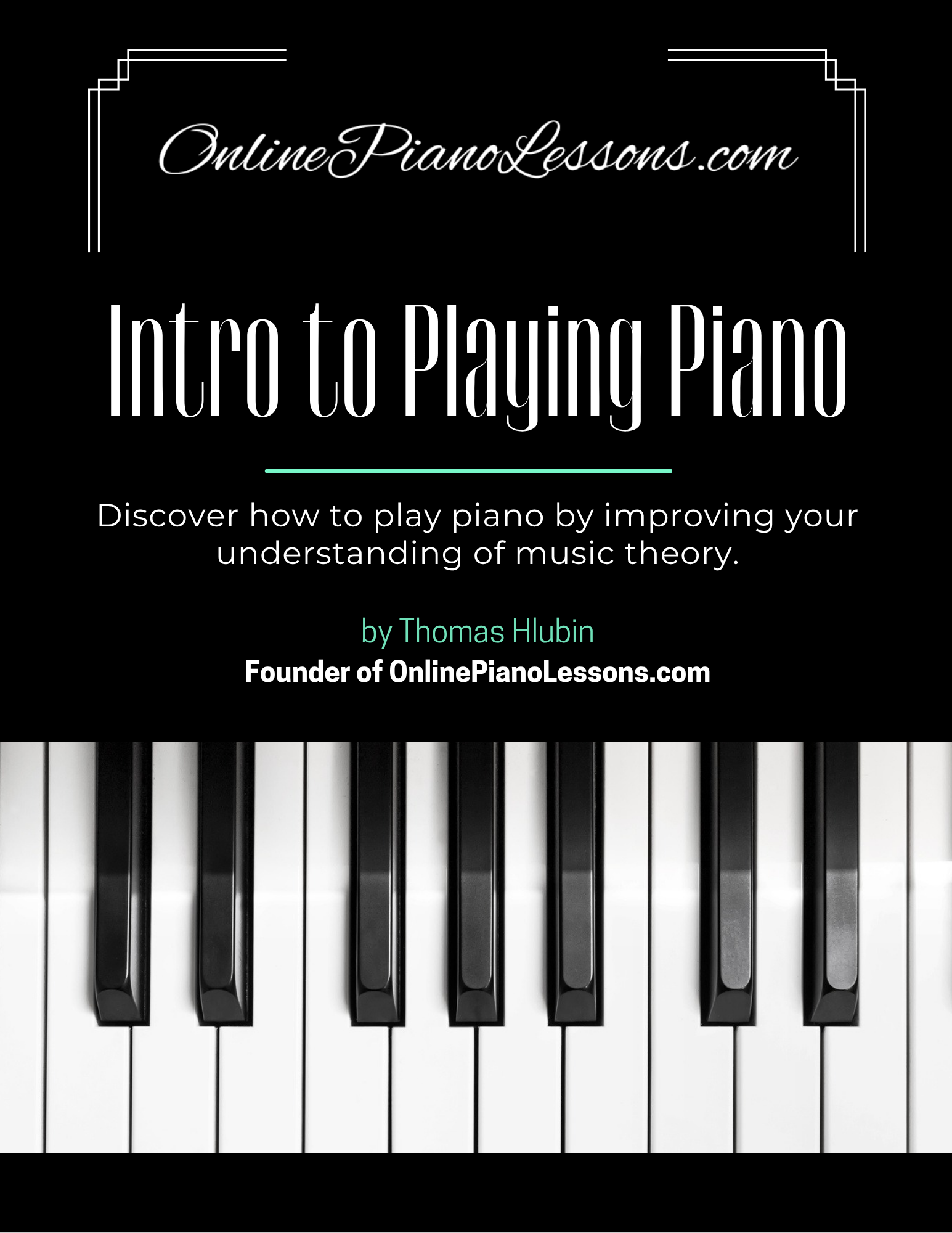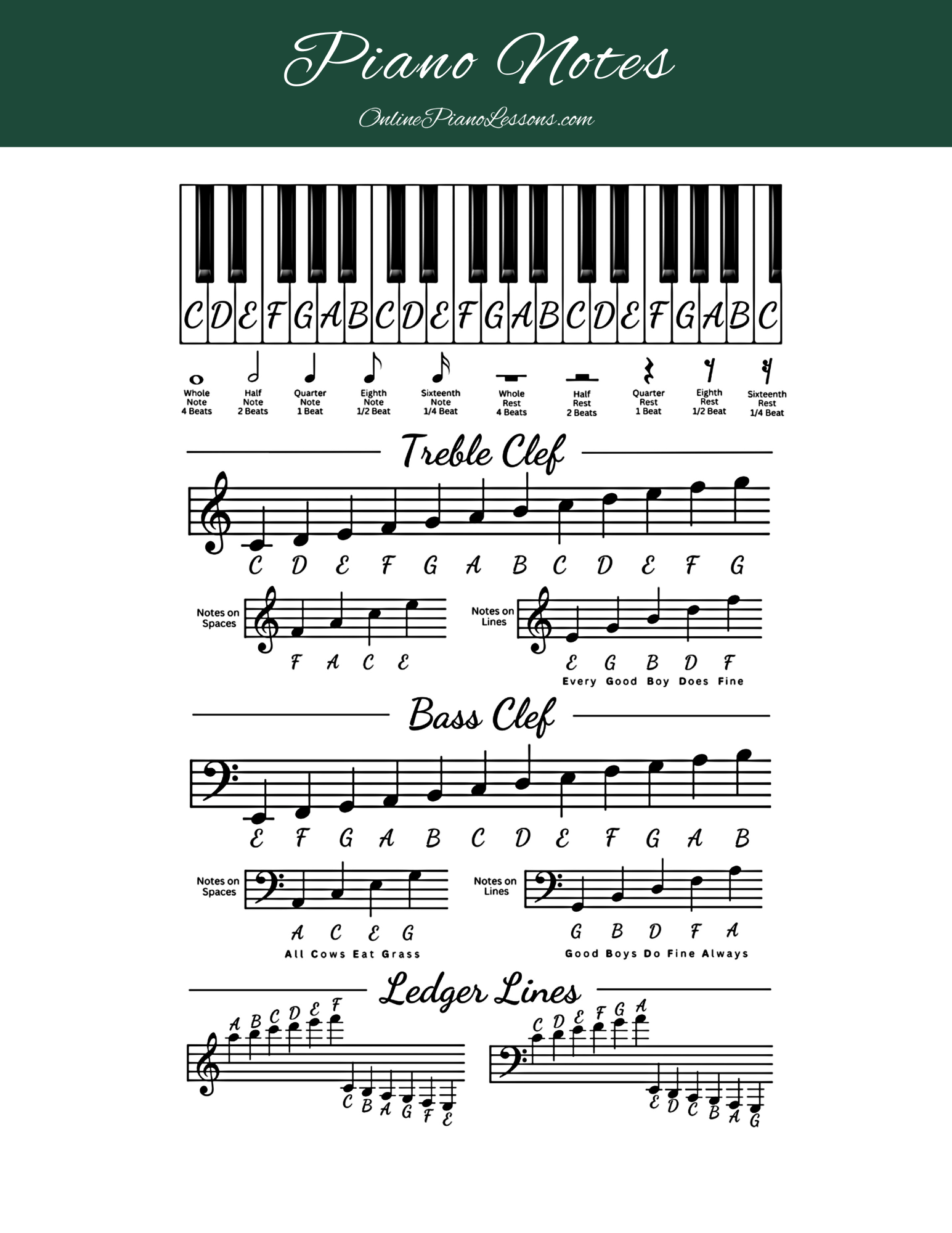
The E♯ major scale (E♯, F𝄪, G𝄪, A♯, B♯, C𝄪, D𝄪) is one of the most fascinating theoretical constructs in music theory—rarely used in practical compositions but incredibly valuable for understanding enharmonic relationships and advanced key signatures.
Quick preview: In this guide, you’ll learn how to play the E sharp major scale on the piano, its unique note structure, why it’s enharmonically equivalent to F major, and how mastering it deepens your fluency in complex tonal systems.
What Is the E♯ Major Scale?
The E♯ major scale is a theoretical major scale built on the note E♯. While it may look intimidating, this scale follows the same whole- and half-step pattern as every major scale:
W-W-H-W-W-W-H
Using that pattern starting from E♯ gives you these notes:
E♯ – F𝄪 – G𝄪 – A♯ – B♯ – C𝄪 – D𝄪 – E♯
If that looks confusing, it’s because this scale is enharmonically identical to F major. In other words, if you play the F major scale on your piano—F, G, A, B♭, C, D, E, F—you’re hearing the exact same pitches as E♯ major. The difference lies entirely in notation, not sound.
So why use E♯ major at all? Mostly for theoretical and compositional clarity when working in sharp-heavy keys or with certain modulations that make E♯ the logical tonic.
The E Sharp Major Scale Notes
Here’s a detailed look at each note in the E♯ major scale and its scale degree:
| Scale Degree | Note | Enharmonic Equivalent |
|---|---|---|
| 1 (Tonic) | E♯ | F |
| 2 (Supertonic) | F𝄪 | G |
| 3 (Mediant) | G𝄪 | A |
| 4 (Subdominant) | A♯ | A♯ |
| 5 (Dominant) | B♯ | C |
| 6 (Submediant) | C𝄪 | D |
| 7 (Leading Tone) | D𝄪 | E |
| 8 (Octave) | E♯ | F |
Because of the multiple double-sharps, the scale looks complex on paper but sounds exactly like F major on your piano.
The E♯ Major Scale Formula
All major scales follow the same pattern of intervals:
Whole – Whole – Half – Whole – Whole – Whole – Half
Applying this pattern to E♯ gives:
- Start on E♯
- Whole step to F𝄪
- Whole step to G𝄪
- Half step to A♯
- Whole step to B♯
- Whole step to C𝄪
- Whole step to D𝄪
- Half step to return to E♯
This formula ensures each scale degree keeps its proper letter name—no note is skipped or repeated.
E♯ Major Scale Piano Fingerings
Even though this scale is theoretical, it’s useful to know the correct fingering if you ever want to practice it for intellectual or technical mastery.
Right Hand: 1-2-3-1-2-3-4-5
Left Hand: 5-4-3-2-1-3-2-1
Since E♯ major is enharmonic to F major, you can use the same fingering as the F major scale, which is comfortable and well balanced for both hands.
E Sharp Major Key Signature
Here’s where it gets truly theoretical:
The E♯ major key signature would contain 14 sharps — two of which are double-sharps (F𝄪 and C𝄪).
That’s why you’ll almost never see this key used in printed music. Instead, composers use F major (with one flat) to represent the same sound, avoiding unnecessary notation complexity.
However, E♯ major might appear as a temporary modulation or spelling choice in pieces that modulate from keys like B♯ major or C♯ major, where the harmonic context demands E♯ as a tonic.
E Sharp Major Scale on the Piano
When playing on the piano, simply play the same notes as you would for F major:
F – G – A – B♭ – C – D – E – F
That’s because every note of E♯ major corresponds enharmonically to a note of the F major scale. So when you practice E♯ major, you’re effectively training your ear and hands for F major, while training your mind to think in E♯ notation.
E♯ Major Scale Chords
Just like any other major scale, the E♯ major scale can be harmonized into diatonic triads (three-note chords).
Here are the chords built on each degree of the E♯ major scale:
| Scale Degree | Chord | Chord Type | Enharmonic Equivalent |
|---|---|---|---|
| I | E♯ major (E♯ – G𝄪 – B♯) | Major | F major |
| ii | F𝄪 minor (F𝄪 – A♯ – C𝄪) | Minor | G minor |
| iii | G𝄪 minor (G𝄪 – B♯ – D𝄪) | Minor | A minor |
| IV | A♯ major (A♯ – C𝄪 – E♯) | Major | B♭ major |
| V | B♯ major (B♯ – D𝄪 – F𝄪) | Major | C major |
| vi | C𝄪 minor (C𝄪 – E♯ – G𝄪) | Minor | D minor |
| vii° | D𝄪 diminished (D𝄪 – F𝄪 – A♯) | Diminished | E diminished |
As you can see, these chords match the harmonic structure of F major exactly—they’re just written differently.
Relative and Parallel Scales
- Relative Minor: C𝄪 minor (enharmonic to D minor)
- Parallel Minor: E♯ minor (enharmonic to F minor)
The relative minor shares the same key signature as E♯ major, while the parallel minor starts on the same tonic (E♯) but uses the natural minor pattern of intervals.
Again, while these are rarely seen in written music, understanding them helps you connect enharmonic and theoretical relationships across the circle of fifths.
Enharmonic Equivalent: F Major
To really drive this home—E♯ major and F major sound exactly the same on a piano or any equal-tempered instrument.
However, the notation choice depends on context. If a composer is working in a piece that modulates upward through sharp keys (say, B major → E major → A♯ major → E♯ major), using E♯ maintains spelling consistency.
It’s the same reason we write G♭ major instead of F♯ major in certain contexts: both sound identical, but one makes theoretical sense depending on the harmonic direction.
Why Learn the E Sharp Major Scale?
Even though you’ll never see E♯ major printed on a recital program, studying it helps you:
- Understand enharmonic equivalence and how notes relate across sharp/flat spellings
- Sharpen your theoretical knowledge for advanced music analysis
- Improve key awareness, especially in modulations and transpositions
- Develop notation fluency when reading complex scores
In short, mastering E♯ major isn’t about performance—it’s about deepening your theoretical understanding.
Practice Tips
- Visualize it as F major. The hand shape and keys are identical.
- Say the note names aloud. This reinforces the theoretical spelling (E♯, F𝄪, G𝄪, etc.).
- Use slow, even tempo practice. Focus on connecting each note cleanly.
- Experiment with chord inversions. Try building triads and seventh chords from each degree.
Final Thoughts
The E♯ major scale may be the most impractical major scale you’ll ever encounter—but it’s a gem for anyone diving into advanced music theory. It connects the abstract side of notation with the concrete experience of sound, showing how flexible our tonal system really is.
By learning the E♯ major scale, you’re not just memorizing another pattern—you’re developing a sharper ear, a smarter mind, and a deeper understanding of harmony.
So the next time someone says E♯ major doesn’t exist, you’ll know exactly why it does—and how to play it perfectly on your piano.
FAQ
Q1: What is the E♯ major scale?
The E♯ major scale is a theoretical major scale that starts on E♯. It follows the standard major scale pattern of whole and half steps (W-W-H-W-W-W-H). Its notes are: E♯, F𝄪, G𝄪, A♯, B♯, C𝄪, D𝄪, and back to E♯. While it looks complex on paper, it sounds exactly like F major on the piano.
Q2: Why is the E♯ major scale so rare?
E♯ major has a highly complex key signature with 14 sharps (including double-sharps), making it impractical for written music. Composers usually write F major instead, which sounds identical but is much easier to read.
Q3: How does E♯ major relate to F major?
E♯ major is enharmonically equivalent to F major. This means that while the notes are spelled differently, they produce the exact same pitches on a piano or any equal-tempered instrument. The choice depends on theoretical context.
Q4: What are the notes and chords in E♯ major?
-
Notes: E♯, F𝄪, G𝄪, A♯, B♯, C𝄪, D𝄪
-
Chords:
- I: E♯ major (E♯–G𝄪–B♯)
- ii: F𝄪 minor (F𝄪–A♯–C𝄪)
- iii: G𝄪 minor (G𝄪–B♯–D𝄪)
- IV: A♯ major (A♯–C𝄪–E♯)
- V: B♯ major (B♯–D𝄪–F𝄪)
- vi: C𝄪 minor (C𝄪–E♯–G𝄪)
- vii°: D𝄪 diminished (D𝄪–F𝄪–A♯)
Q5: How do I play the E♯ major scale on piano?
Since it’s enharmonic to F major, you can play it using the F major fingering:
- Right Hand: 1-2-3-1-2-3-4-5
- Left Hand: 5-4-3-2-1-3-2-1
Visualizing it as F major simplifies learning and practice.
Q6: Does E♯ major have a relative or parallel minor?
Yes!
- Relative Minor: C𝄪 minor (enharmonic to D minor)
- Parallel Minor: E♯ minor (enharmonic to F minor)
Q7: Why should I bother learning E♯ major?
Even if you won’t see it in printed music, studying E♯ major helps you:
- Understand enharmonic equivalence
- Improve advanced theoretical knowledge
- Recognize complex key relationships and modulations
- Develop notation fluency for reading sharp-heavy scores
Q8: Any tips for practicing E♯ major?
- Visualize it as F major to simplify fingering.
- Say the note names aloud to reinforce theoretical spelling.
- Practice slowly and evenly to connect each note clearly.
- Experiment with triads and seventh chord inversions for each scale degree





 Hi, I'm Thomas, Pianist Composer,
Hi, I'm Thomas, Pianist Composer,  I love playing piano, creating new melodies and songs, and further developing my online piano course and making updates/additions to my site OnlinePianoLessons.com!
I love playing piano, creating new melodies and songs, and further developing my online piano course and making updates/additions to my site OnlinePianoLessons.com!  Now that is what I call fun!
Now that is what I call fun!
